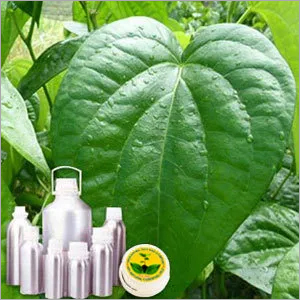 | Botonical Name | : | Piper betle |
 | CAS # | : | 84775-81-5 |
 | Country of Origin | : | India |
 | Color & Odor | : | Clear yellow to dark brown liquid with creosote-like odor |
 | Solubility | : | Soluble in alcohol and oils. Insoluble in water. |
 | Specific Gravity | : | 1.0440 - 1.0540 @ 25°C |
 | Optical Rotation | : | -1.5 - -4 @ 25°C |
 | Refractive Index | : | 1.500 - 1.5240 @ 25°C |
 | Flash Point | : | > 100°C |
 | Major Constituents | : | eugenol, betel phenol, chavicol |
 | Plant Part Used | : | Leaf |
 | Extraction Method | : | Steam Distillation |
DESCRIPTION:
Betel Leaf Oil is extracted from the heart shaped leaves of this plant. The obtained fragrant oil has long lasting soothing smell. The leaf of this plant acts as amazing mouth freshener when chewed with other ingredients. CONSTITUENTS:
phenols including hydroxychavicol, eugenol, betel phenol, chavicol, Linalool, MyrceneAROMATIC SUMMARY / NOTE / STRENGTH OF AROMA:
The middle note aroma of this Betel Leaf Oil slightly resembles to the smell of creosote. BLENDS WITH:
Betel Leaf Oil easily mixes with other essential oils extracted from Cardamom, Tea Tree, Lavender, Rosemary and Eucalyptus. COMMON NAMES:
Betel Leaf Oil is commonly known as Betel Essential Leaf Oil, Carum Copticum oil, Copticum oil and Paan oil. USES:
In Ayurveda, this essential oil is known for its fragrant, warming, antiseptic and stimulating attributes. Betel Leaf Oil is also reckoned for its therapeutic value and is useful for enhancing strength of teeth and gum. It also helps to improve voice quality and refreshes breath. 


































